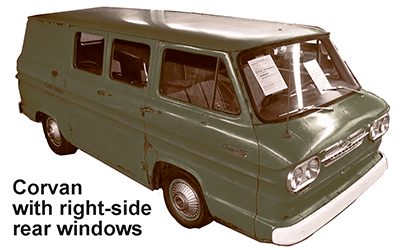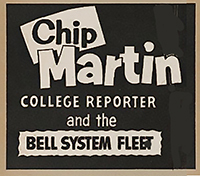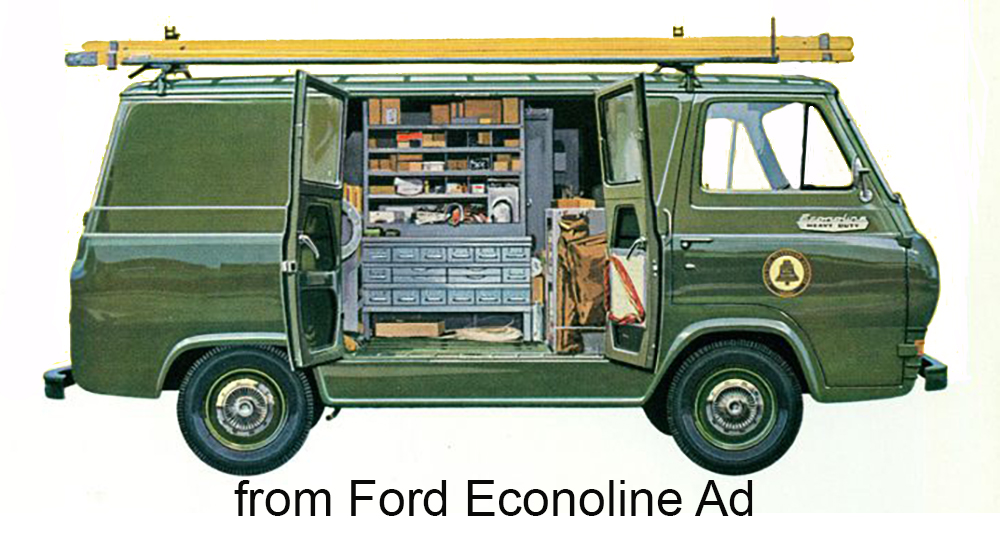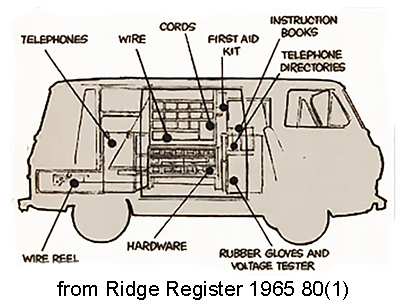The ”Bell System” was the group of subsidiary (“operating”) companies headed by AT&T (“Ma Bell”) prior to its divestiture in 1984. There were 23 continental U.S. regional operating companies that provided local phone service, sales, and infrastructure support. Other divisions included AT&T Long Lines, Bell Labs, and Western Electric, which were the long-distance service, research, and manufacturing arms of the corporation, respectively.

The regional operating companies employed a variety of vehicles, including cars, half-ton, three-quarter, one-ton, and larger trucks to provide customer and line services. Standardized vehicles first entered the fleet in the late 1920s, typified by Ford Model A “Runabout” trucks, which evolved into the more substantial half-ton trucks of the 1940s and ‘50s. The typical “installer truck” that provided customer service was a conventional half-ton truck cab with a box-like storage unit mounted on the chassis rear. The J.H. Holan Company designed many of the truck bodies used by the Bell System and their half-ton “IU-76” installer truck was so common in the 1950s that it was almost emblematic of the Bell System.
Installer trucks carried over 150 different items including repair parts of all sorts, spools of interior wire, reels of exterior “drop line” cable, tools for inside and outside work, clothing should the weather turn inclement, ladders tall and short, a small library of directories and manuals, and more. These trucks were also a mobile retail store. The Bell System “Craftsman” was expected to sell the latest in wall-mounted, desk set, and Princess telephones, and the truck needed to stock these phones for the sale to transpire.
The carrying capacity of installer trucks was increasingly strained by additional new equipment and expanding products lines, such as with the “Color Comes Calling” campaign of the mid-1950s which brought colored telephones to the market. The basic design of the truck body was problematic as well. The storage lockers, bins, and drawers were accessible “from the outside looking in” through doors along the sides and rear of the truck, which left contents exposed to the elements and subject to pilferage.
Cost-effectiveness is important for any large fleet and especially for a utility company such as AT&T for which rates and profits were regulated. Of its almost 100,000 fleet vehicles in 1960, around 60,000 were in the half-ton class. They represented a $130 million investment with an annual operating cost of $67 million. And the cost had been mounting. Cab interiors had become more luxurious than needed and fuel economy had diminished as the weight and HP of the truck engines increased. Installer trucks had a service life of 6 - 8 years and averaged only around 8000 miles per year. At 11 mpg, gassing-up the half-ton fleet ran to $13.5 million annually ($140M in 2023 dollars). By the late 1950s, AT&T was actively seeking an alternative.

Bell System Corvair 95s - Bell Labs explored a variety of alternative truck designs. It drew upon a survey of subsidiaries to build and test several prototype vehicles. Also tested were vehicles from overseas markets, including the VW Kombi, Ford Thames, International Harvester Metro-Mite, and the Renault Petit-Panel and Hi-Boy vans; however. None were found satisfactory. The Bell System was more enthusiastic about the new U.S. made compact vans and pickups that entered the market in 1960, the Chevrolet Corvair 95 and Ford Econoline. These short wheel-base, forward control vehicles introduced a light weight unibody construction that provided improved cargo space, load capacity, and security, at an economic price. The moderate vehicle height was also important to allow access to extension ladders carried on the roof.

There is very little historical documentation about Bell System Corvair 95s, and, like the Bell subsidiary companies themselves, most have long since passed into oblivion. Actual documentation confirms that Corvair 95s were in the fleets of the British Columbia Telephone Company, Conestaga Mutual Telephone Company, GTE, Michigan Bell, New England Telephone and Telegraph, New York Bell, Pacific Southwest Bell, and Pacific Northwest Bell, although many other subsidiaries undoubtedly also tested Corvair 95s. The phone company FCs in the Corvanatics Corvair 95 Registry are either Rampsides or Corvans. Although none of these are 8-door vans, some vans with left-side doors reportedly were from phone companies. These were unlikely to have been standard service vehicles, considering the added cost and potential interference with shelving space. Pickups would have been purchased for use by lineman crews and may have received gantry arms to help load and unload large reels of transmission cable on the side ramp. The metal bracket visible in the Rampside in the figure probably served in phone company functions.
Serial Number - It would be expected to find serial numbers of Bell System FCs to fall in clusters, since all the vehicles of an order from a large corporation would typically roll off the assembly line in short order, with a narrow range of serial numbers. While we currently do not know of enough existing Bell System vehicles to see this clustering, this has been observed for government fleet vehicles delivered to the Department of Interior in 1962. In that case 5 vehicles with the identical Government contract number ("C 62 200") embossed on the VIN plate have St Louis serial numbers between 110274 - 110476. The image shows a legal notice from the British Columbia Phone Company of an auction of decommissioned vehicles, including two 1962 Corvans with Flint serial numbers only 6 vehicles apart.
While we currently do not know of enough existing Bell System vehicles to see this clustering, this has been observed for government fleet vehicles delivered to the Department of Interior in 1962. In that case 5 vehicles with the identical Government contract number ("C 62 200") embossed on the VIN plate have St Louis serial numbers between 110274 - 110476. The image shows a legal notice from the British Columbia Phone Company of an auction of decommissioned vehicles, including two 1962 Corvans with Flint serial numbers only 6 vehicles apart.
 Windows -Bell System companies characteristically ordered Corvans with windows added to the right-side or both sides. Unlike Greenbriers, the windows in the doors lacked roll-down mechanisms. Ford also provided Econoline cargo vans with right-side windows that were used by the phone companies. These were regular production model “89E” and called a “Display van”. From Chevrolet, the additional windows were available only as a special Central Office Production Order (COPO). It seems likely that widows were added to provide interior illumination. Standard installer vans received windows only on the right side, allowing a Bell Labs-designed shelving rack (see below) to be positioned along the left side panel. Corvans with windows on both sides possibly carried rear seats for passengers or received shelving designed by a conversion company such as the Utility Body Company (see below).
Windows -Bell System companies characteristically ordered Corvans with windows added to the right-side or both sides. Unlike Greenbriers, the windows in the doors lacked roll-down mechanisms. Ford also provided Econoline cargo vans with right-side windows that were used by the phone companies. These were regular production model “89E” and called a “Display van”. From Chevrolet, the additional windows were available only as a special Central Office Production Order (COPO). It seems likely that widows were added to provide interior illumination. Standard installer vans received windows only on the right side, allowing a Bell Labs-designed shelving rack (see below) to be positioned along the left side panel. Corvans with windows on both sides possibly carried rear seats for passengers or received shelving designed by a conversion company such as the Utility Body Company (see below).
A Corvan cost around $300 less than the Greenbrier and adding fixed-place windows to a Corvan was less expensive than buying a fully windowed Greenbrier. To give an idea of what COPO windows may have cost, in 1963 when windows in the rear door of the Corvan were made optional, adding those windows (RPO A12) cost $12.95. Because these windows were occasionally added to other commercial FCs, their presence is not proof of a Bell System origin.
Exterior Paint & Paint Codes - The classic green color of Bell System trucks originated in the early 20th century and was used through the 1960s. The color was referred to as “Bell System Green” or sometimes “Bell Green” and varied somewhat among paint manufacturers and subsidiary companies. A Bell System history web page states that the official color of this Bell System paint was Sherwin Williams "Bell System Green-Gray, JX-6047"; however, I have not found a source to confirm this. The "JX" numbers are obsolete and although Sherwin Williams' records still include the color name, there is no number or formula associated with it. Other paint manufacturers and automakers had their own paint formulas and numbers for the Bell System Green. For example, in the early 1960s, “93-546” was the Dupont code for “Bell Green” and “98L-1640” was the Martin-Senour code. The monotone color theme was formally phased out in 1969 when Bell system adopted a multicolor theme. Concerns had long been raised about the poor visibility of Bell System Green, and some subsidiaries (such as NJ Bell) tested an orange exterior in the mid-1950s.

I have observed three vans that have good quality original or restored Bell System Green paint, and a half dozen or so with well-patinaed exteriors and potentially restorable. Others exist that display little evidence of their earlier life, although remnants of original paint confirm the vehicle’s history.
The data plate of a Bell system FC typically shows "SPEC" (special) as the Paint Code, meaning that a non-standard RPO exterior paint was applied at the factory. However, this alone does not confirm Bell System origin since the SPEC (or “SPC”) codes were used for many commercial FCs. An interesting case is the 1964 Rampside, S/N S111357, with the paint code "0780-546". Much sleuthing by Kent Sullivan and Dave Newell eventually connected the "546" to the Dupont Bell Green color code. The "0780" may be a special Chevrolet Class-A fleet code.

Cab Interior - A driver-side half-bench seat was standard for a Corvan and would be expected in most installer vans. Since this seat was not an option for pickups, Loadsides and Rampsides would have had a full bench seat. Although a second half-bench seat may have been installed after the Covan was decommissioned, it would be surprising to see these ordered for the fleet. The auxiliary passenger side seat was introduced in 1962 and designed to fold forward to allow the driver to climb into the cargo area. This would have served no purpose in an installer van with storage racks against the cab. If additional seating was required, ordering the full bench seat, at half the price of two half bench seats, was more cost effective.
The standard installer van was strictly utilitarian and the accoutrements of the cab would have been relatively sparse. Routine fleet vehicles would have been ordered with standard trim, indicated by “STD” on the data plate, which included only the driver-side sun visor. Custom Equipment ("Deluxe") trim is found for some phone company vans in the Registry, maybe for supervisors. The $20 deluxe trim package was a rather skimpy deal and included the driver side arm rest, cigarette lighter, and a passenger side sun visor (a passenger side arm rest was not available). Neglecting the passenger in a standard van wasn’t a problem since Craftsmen were strongly discouraged from carrying passengers.
While the optional AM radio would have been an unjustified luxury, some vans were equipped with a two-way FM radio. These vans would have had an antenna mounted on the left side rear panel. Standard equipment did not include a heater, so the forced air heater would have been ordered by Bell subsidiaries in colder climes.

Storage Units-Considering the large number of items0 stocked within an installer truck, the storage space of the new compact vans needed to be carefully managed. The Bell Lab facility in Chester NJ, designed the interior storage units and roof-top ladder mounts and provided the specifications to after-market conversion companies for fabrication and installation. The basic layout was similar for the Corvair 95 and Econoline. There was a tall storage cabinet with drawers and bins along the left side wall and smaller units on either side. Facing the rear doors were racks with new telephones and other products. The very rear (over the engine in the Corvair 95) was generally left exposed except for spools and reels of wire.
One historical document shows that the Conestaga Mutual Telephone Company, Morgantown, PA, purchased a 1963 Corvan for $2894 and the ~$700 over the manufacturer’s suggested retail price may reflect the cost with the storage units and other customizations.
We would expect that Corvair 95s and Econolines serving similar functions would have carried similar supplies and were outfitted with similar shelving and storage units. And the interiors do look similar. Thus, images of the Econoline interior provide insight into the shelving and compartments used in a Corvan.
Operating companies were not required to use Bell Labs-designed interiors. Some phone companies used vans with storage units designed by after-market conversion companies such as the Stahl Metal Products and Utility Body Company, which advertised annually in the Chevrolet Silver Book.


For the inquisitive, here are links to a Bell System article about the Evolution of Service Vehicles and a cartoon, "Chip Martin, College Reporter and the Bell System Fleet".


Provenance - The Bell System emblem was modified in both 1960 and 1964, although the changes were not immediately adopted system wide. The emblems were sometimes customized to include the name of the local subsidiary. The emblems were often found on the front and rear doors. A much more stylized bell was introduced in 1969.
Some of the best evidence of a phone company history is provenance in the form of Bell system paperwork, registration forms, labels, and plaques inside or outside the vehicle. The Southwestern Bell Rampside shown in Figure 2 is one of the best documented, still having a Texas state registration form identifying SW Bell as the owner. Vehicles may also have plaques and stickers with company policies. The safety creed, which was first adopted in 1939 was reportedly required in all company vehicles.
Being Better did not Garantee Success - The Econoline and the Corvair 95 entered the foray somewhat neck-and-neck. Reviews for both were positive and tended to favor the Corvair 95 for its large payload, better handling, aesthetic design, and probably in part, for the sheer boldness of its innovative engineering. The Bell system subsidiaries quickly began to replace the traditional installer trucks. For example, Pacific Telephone and Telegraph had 955 trucks in its half-ton class in 1960 and was expecting to replace 20% annually with a mix of both models. The Bell System overall acquired around 500 compact vans that first year, subsequently replaced about 5000 annually. By 1964 there were over 15,000 compact vans in the fleet.
Ford data shows 9361 standard Display Vans were produced between 1963 and 1965, and it’s likely many of these went to phone companies. There are no known records of the number of Corvair 95s purchased by phone companies, but evidence indicates it was far fewer. The Econoline-emulating Chevy Van and the Dodge A-100 both joined the market in 1964 and further diminished interest in their rear-engined competitor. The Corvair 95 was the superior vehicle on several accounts, so why did the Corvair 95 so quickly fall out of favor with the Bell System?
The Corvair 95’s four-wheel independent suspension afforded superior ride and handling. The small, light-weight rear-mounted engine yielded a lower-setting, more accessible load area, greater load capacity, and more roomy cab space. And for the Rampside, accessibility of the bed was unprecedented by virtue of the side ramp. But the Corvair 95’s superior design could not compete with the more barebones Econoline. On one hand, servicing was an issue. Mechanics were more at home working on the Econline's traditional straight six engine and there are various accounts of Corvair 95s requiring more service time. And there was no hiding the hump – the elevated engine compartment in the rear of the Corvair 95’s cargo bed. Because the engine was mounted forward, the Econoline’s load space was more functional than that of the Corvan. Econoline advertisements often showed an open-door rear view and the tag line “No Rear Engine Hump”.
But more importantly, the Corvair 95 could not successfully compete on the one account most important to corporate accountants. Base model Econoline vans were around $300 less than the Corvan and $200 less for the pickup than the Rampside. Phone companies would have qualified for GM Class A fleet user certification and received a discounted price for the vehicles they purchased, but Ford would have done likewise. Ford also aggressively promoted the Econoline’s austerity with advertisements in telecom trade journals touting savings in fuel economy, oil usage (only 3½ quarts), tire life, and even less expensive state licensing fees!
Since comfort was not a primary concern, the standard leaf spring suspension was sufficient and less expensive than the four-wheel independent suspension of the Corvair 95. Fuel economy was obviously important and the few MPG advantage for the Econoline would have translated to millions of dollars in savings for the Bell System fleet. By late 1961 Ford could claim the Econoline was “America’s Most Popular Van” and the “All-Round Economy Leader”.
Chevrolet’s confidence in the Corvair 95 was severely shaken when sales plummeted early in 1961 and it appeared to effectively concede the large fleet user market. In 1961 Chevrolet ran hundreds of advertisement inserts for the Corvair 95 in over a hundred different trade journals and magazines; in 1962, advertising was reduced nearly 75%. There was a half-hearted attempt to salvage the line through cost-saving design changes in 1963, and despite a moderate increase in advertising, the Corvair 95 was relegated to the advertising backwater. Advertisements in telecommunication journals such as Telephony and Telephone Engineer and Management were almost nonexistent in 1963 and ’64. A Bell System fleet powerhouse the Corvair 95 was not to be.

A Bell System fleet, scaled down - No discussion of Bell System Corvair 95s would be complete without a nod to the Tatsuya toy company in Japan for producing a scale model of the van. This was one of fourteen Corvair 95 friction drive toys that Tatsuya produced under the KTS trademark – 6 Corvans, 4 Greenbriers, and 4 Rampsides. Several of these carried corporate insignias including Coca Cola, REA Express and Bell Telephone. The Bell System van is quite nicely manufactured, painted Bell System Green with a Bell System emblems, though missing the right side windows. At least Phone company Corvair 95s outnumbered Econolines in Tatsuya’s fleet.
Anonymous. (1960) AT&T Tries Compact Trucks. Automotive News Vol 36 (3801): 22-24 Anonymous. (1960) Corvan and Econoline May Fill Bell System Needs. Trucking News Vol 27: 10 Anonymous. (1960) Truck Highlights for 1961. Motor Age: Nov: 38-42. Anonymous, (1960) Accent on Thrift Puts Compacts Into High Gear. Purchasing Week: 51(3): 1. Coe, R.S. (1931) The Growing American Taste for Beauty and What the Bell System is Doing to Satisfy It. Bell Telephone Magazine Vol 10 (2): 103 – 114. Baillard, V.H. (1965) Chester: The Outside Plant in Field Laboratory Form. Bell Laboratories Record Vol 43(4): 114 – 119. Glynn, F.K. (1954) Maintaining an Efficient Automotive Fleet. Bell Telephone Magazine 33: 191-199. Herrmann, C. S. (1964) Evolution of Work Vehicles. Bell Laboratories Record Vol 42(8): 298-299. Hooven, J.J. (1961) The Ford Econoline in Fleet Applications. SAE Presentation January 9-13. MacDougall, J. (1960) Light Truck Development in the Bell System. SAE Technical Paper 610203. NY Telephone (1969) Station Installation and Maintenance Handbook. Reynolds, Dick (1961) Plant Men Look Over the Compact Car Field. Telephone Engineer and Management Vol 65 (8): 66 Smith, T.C. (1947) Keeping our Automotive Equipment Modern. Bell Telephone Magazine pp 90-99







